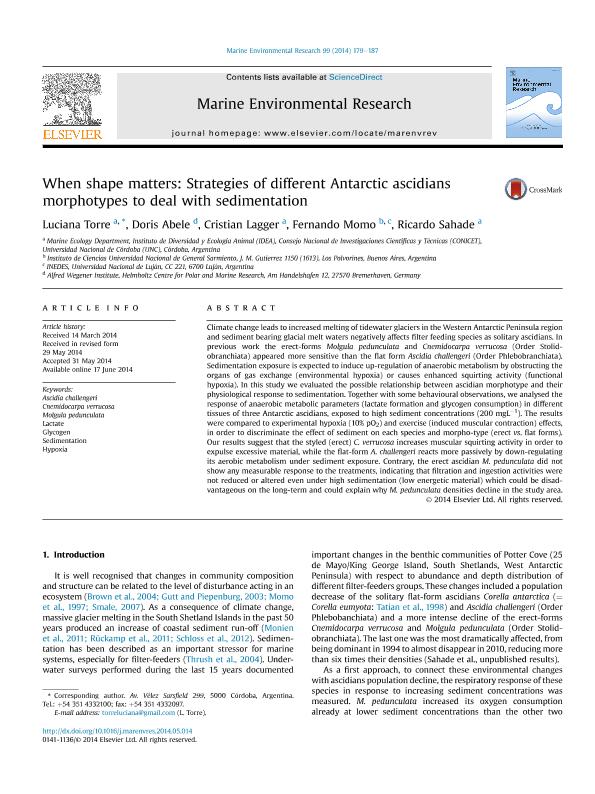Mostrar el registro sencillo del ítem
dc.contributor.author
Torre, Luciana

dc.contributor.author
Abele, Doris
dc.contributor.author
Lagger, Cristian Fabian

dc.contributor.author
Momo, Fernando
dc.contributor.author
Sahade, Ricardo Jose

dc.date.available
2016-11-04T22:12:31Z
dc.date.issued
2014-05
dc.identifier.citation
Torre, Luciana; Abele, Doris; Lagger, Cristian Fabian; Momo, Fernando; Sahade, Ricardo Jose; When shape matters: Strategies of different Antarctic ascidians morphotypes to deal with sedimentation; Elsevier; Marine Environmental Research; 99; 5-2014; 179-187
dc.identifier.issn
0141-1136
dc.identifier.uri
http://hdl.handle.net/11336/8012
dc.description.abstract
Climate change leads to increased melting of tidewater glaciers in the Western Antarctic Peninsula region and sediment bearing glacial melt waters negatively affects filter feeding species as solitary ascidians. In previous work the erect-forms Molgula pedunculata and Cnemidocarpa verrucosa (Order Stolidobranchiata) appeared more sensitive than the flat form Ascidia challengeri (Order Phlebobranchiata). Sedimentation exposure is expected to induce up-regulation of anaerobic metabolism by obstructing the organs of gas exchange (environmental hypoxia) or causes enhanced squirting activity (functional hypoxia). In this study we evaluated the possible relationship between ascidian morphotype and their physiological response to sedimentation. Together with some behavioural observations, we analysed the response of anaerobic metabolic parameters (lactate formation and glycogen consumption) in different tissues of three Antarctic ascidians, exposed to high sediment concentrations. The results were compared to experimental hypoxia (10% pO2) and exercise (induced muscular contraction) effects, in order to discriminate the effect of sediment on each species and morpho-type (erect vs. flat forms). Our results suggest that the styled (erect) C. verrucosa increases muscular squirting activity in order to expulse excessive material, while the flat-form A. challengeri reacts more passively by down-regulating its aerobic metabolism under sediment exposure. Contrary, the erect ascidian M. pedunculata did not show any measurable response to the treatments, indicating that filtration and ingestion activities were not reduced or altered even under high sedimentation (low energetic material) which could be disadvantageous on the long-term and could explain why M. pedunculata densities decline in the study area.
dc.format
application/pdf
dc.language.iso
eng
dc.publisher
Elsevier

dc.rights
info:eu-repo/semantics/openAccess
dc.rights.uri
https://creativecommons.org/licenses/by-nc-nd/2.5/ar/
dc.subject
Ascidia Challengeri
dc.subject
Cnemidocarpa Verrucosa
dc.subject
Molgula Pedunculata
dc.subject
Lactate
dc.subject
Glycogen
dc.subject
Hypoxia
dc.subject
Sedimentation
dc.subject.classification
Biología Marina, Limnología

dc.subject.classification
Ciencias Biológicas

dc.subject.classification
CIENCIAS NATURALES Y EXACTAS

dc.title
When shape matters: Strategies of different Antarctic ascidians morphotypes to deal with sedimentation
dc.type
info:eu-repo/semantics/article
dc.type
info:ar-repo/semantics/artículo
dc.type
info:eu-repo/semantics/publishedVersion
dc.date.updated
2016-11-02T18:13:46Z
dc.journal.volume
99
dc.journal.pagination
179-187
dc.journal.pais
Países Bajos

dc.journal.ciudad
Amsterdam
dc.description.fil
Fil: Torre, Luciana. Consejo Nacional de Investigaciones Cientificas y Tecnicas. Centro Cientifico Tecnologico Cordoba. Instituto de Diversidad y Ecologia Animal; Argentina
dc.description.fil
Fil: Abele, Doris. Alfred Wegener Institute; Alemania
dc.description.fil
Fil: Lagger, Cristian Fabian. Consejo Nacional de Investigaciones Cientificas y Tecnicas. Centro Cientifico Tecnologico Cordoba. Instituto de Diversidad y Ecologia Animal; Argentina
dc.description.fil
Fil: Momo, Fernando. Universidad Nacional de General Sarmiento. Instituto de Ciencias; Argentina. Universidad Nacional de Lujan. Instituto de Ecologia y Desarrollo Sustentable; Argentina
dc.description.fil
Fil: Sahade, Ricardo Jose. Consejo Nacional de Investigaciones Cientificas y Tecnicas. Centro Cientifico Tecnologico Cordoba. Instituto de Diversidad y Ecologia Animal; Argentina
dc.journal.title
Marine Environmental Research

dc.relation.alternativeid
info:eu-repo/semantics/altIdentifier/url/http://www.sciencedirect.com/science/article/pii/S014111361400107X
dc.relation.alternativeid
info:eu-repo/semantics/altIdentifier/url/http://dx.doi.org/10.1016/j.marenvres.2014.05.014
Archivos asociados
